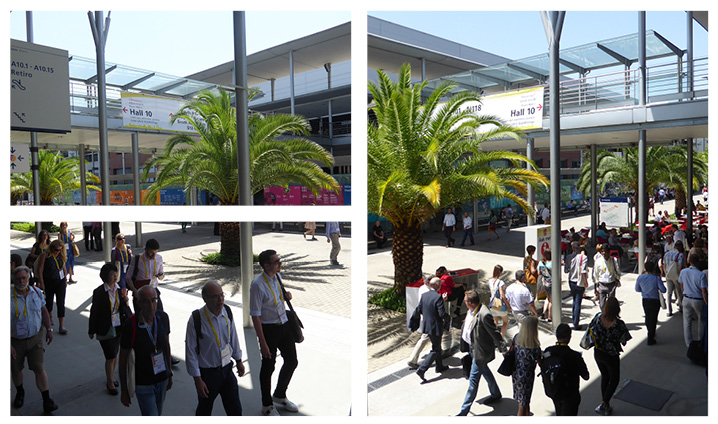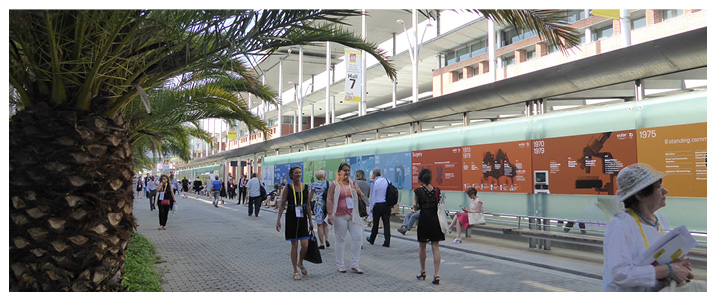Madrid, Spain’s magnificent capital city, was the location for the 18th European League Against Rheumatism (EULAR) Annual European Congress of Rheumatology, held from 14th–17th June 2017. Welcoming attendees from 120 countries worldwide, EULAR was held in the impressive IFEMA conference centre in close proximity to the vibrant city centre, bursting with history, culture, and impressive architecture. The 2017 event marked the 70th anniversary of the EULAR society, and the organising committee ensured that the celebrations did not go unnoticed!
The scale of this year’s event was evident; >14,000 participants flooded the congress centre, an impressive 180 scientific sessions and interactive poster tours were available, and >4,850 abstracts were submitted. Of these abstracts, 74% were either accepted for presentation or publication. Once again, EULAR provided a unique and exciting opportunity for the exchange of clinical and scientific information, and the perfect occasion to recognise the importance of health professionals and patient organisation collaboration, for advancement within the field.
There was a heavy emphasis on the exciting launch of the general EULAR campaign, “Don’t Delay, Connect Today!”, which is centred around early recognition and treatment of rheumatic and musculoskeletal diseases. Attendees could efficiently schedule which sessions to attend using the official EULAR Congress App, which also allowed access to a plethora of scientific content following the event.
In our congress review section, we present you with the highlights and key discussion topics, as a welcoming reminder for those present, as well as a concise and informative overview for those who were unable to attend. During the opening ceremony, EULAR’s President, Prof Gerd R. Burmester, spoke of EULAR’s past, present, and future goals. To commemorate the 70 years of EULAR, attendees were guided through the timeline, at each time point reflecting on the most prominent achievement. Prof Burmester emphasised: “The World Health Organization (WHO) recognised the fundamental importance of the medical muscular skeletal diseases, in this year 2016, and you all know without the recognition of WHO, it is very difficult to tell the politicians that these diseases are very important.”
Looking towards the future, Prof Burmester provided a 2020 vision update, and discussed the seven EULAR objectives for 2017. When discussing the objectives, he commented: “Most of them have been reached, one was, we wanted to be the central platform to facilitate and stimulate innovative basic and clinical research projects.” He continued: “The next one was education, we want to be the provider and facilitator of high-quality educational events, and what about the congress, we are here, we want to make it the top congress for rheumatic and musculoskeletal diseases.”
The opening ceremony also featured the award winners of the congress in order to honour their outstanding contributions to the field of rheumatology. The Health Professionals in Rheumatology and PARE award winners included Mr Huang Zhengping (China) for his feasibility study for use of telemedicine in patients with ankylosing spondylitis, Dr Wilfred Peter (Netherlands) for his role as study lead for the reliability, responsiveness, and interpretability of the Animated Activity Questionnaire, designed to measure the limitations in hip and knee osteoarthritis, as well as Ellen M. H. Selten (Netherlands) and Karl Cattelaens (Germany) for their research. The awardees of the basic science and clinical abstracts were also recognised.
The presentation and symposium topics were extensive and all-encompassing, with something for every attendee from across the board. In the following review highlights, we summarise the very latest cutting-edge research and clinical data from across Europe. With EULAR’s unshaken reputation as one of the best events for professional development for the practising physician and health professional, I am confident we will see many of you at next year’s congress, due to be held in the thriving city of Amsterdam, Netherlands.
We hope you will enjoy reading the EULAR highlights, and I am sure you will all join us here at EMJ in wishing EULAR a very happy 70th anniversary!

Dramatic Increase in Uptake of Pneumococcal Vaccination
THOUSANDS of lives could be saved using a nurse-led pneumococcal vaccination programme for vulnerable rheumatic patients, according to a EULAR press release dated 15th June 2017. As a population with previously low pneumococcal vaccination rates, this is a crucial development for many of these high-risk patients.
Dr Tiphaine Goulenok and colleagues at the Bichat Hospital, Paris, France, successfully implemented a vaccination programme run by nursing staff to improve pneumococcal vaccination coverage amongst susceptible rheumatic patients. Dr Goulenok explained: “Patients with chronic inflammatory rheumatic diseases and receiving immunosuppressive therapies are at increased risk of dying from infections compared with the general population.”
The group screened 126 adult patients with a chronic inflammatory rheumatic disease admitted to the day hospital unit at Bichat Hospital over a 4-month period. Overall, 76 patients were suitable for pneumococcal vaccination, based on French national recommendations, because they were receiving prednisone, immunosuppressive drugs, and/or biotherapy. Among the 63 of these patients who had not previously received the pneumococcal vaccination but were eligible, 56 patients were successfully identified by nursing staff as requiring the vaccination, and subsequently 46 of these patients agreed to be vaccinated. The study confirmed that there was a significant improvement (p<0.001) in the rate of pneumococcal vaccination after the introduction of the nurse-led programme, compared to before the programme was implemented.
Dr Goulenok commented: “Our study has shown that nurses can play an important role in improving the uptake of pneumococcal vaccination in these vulnerable patients.” Indeed, since this population has a low rate of pneumococcal vaccination, nurses have a key role in potentially saving thousands of lives.
New Prediction Model for Relapse in Rheumatoid Arthritis Patients
A COMBINATION of two measurements has been reported to enable tapering of disease-modifying anti-rheumatic drugs (DMARDs) in rheumatoid arthritis (RA) patients: multiple-biomarker disease activity (MBDA) score and anti-citrullinated protein (ACPA) status. This study was discussed in a EULAR press release dated 16th June 2017. Currently, ˜50% of patients with RA achieve disease remission with the use of DMARDs. Once a patient is in remission, the question for rheumatologists is whether treatment can be tapered or stopped completely. Additionally, it is important to determine patients at particular risk of relapse as a result of tapering treatment.
The RETRO study had previously found that >50% of patients remain in remission after tapering or stopping DMARD treatment. Furthermore, the presence of ACPA was found to be associated with relapses. This study tested a risk-stratified tapering model to predict relapse rates; MBDA and ACPA status were used as predictive markers.
One hundred and forty-six patients with RA were randomised into three study arms: one arm tapered their DMARD dose by 50%, one arm ceased DMARD treatment after 6 months of treatment, and the third arm continued DMARD treatment. After an observation period of 1 year, it was determined that the patients at the lowest risk of relapse (19%) were those with a negative ACPA status and a low MBDA score of <30. A relapse risk of 61%, the highest in this study, was found in patients with double-positive ACPA.
This finding is expected to have great utility in terms of economic savings, with the authors estimating that stopping DMARD treatment after tapering resulted in a 75% reduction in drug costs over the 1-year period. The study’s lead author, Dr Melanie Hagen, Friedrich-Alexander University Erlangen-Nürnberg, Erlangen, Germany, expanded: “Having shown in the RETRO study that those RA patients who relapse after tapering their DMARDs respond well to their reintroduction, a structured tapering and stopping of DMARDs is not only a cost economic strategy but also clinically feasible.”

New Drug Classes for the Treatment of Psoriatic Arthritis
PROMISING new data supports two new drug classes for the treatment of psoriatic arthritis (PsA), as suggested by the results of studies reported in a EULAR press release dated 16th June 2017.
In a Phase III study, 422 patients with PsA were randomised and treated with either twice-daily tofacitinib tablets (either 5 mg or 10 mg), a subcutaneous adalimumab injection every 2 weeks (40 mg), or placebo. Tofacitinib, an oral Janus kinase inhibitor, was shown to be superior to placebo in terms of American College of Rheumatology 20 criteria (ACR20) response rates as early as 2 weeks into treatment, and this was maintained for 12 months (p<0.001 [5 mg]; p<0.0001 [10 mg]). “Since tofacitinib is a tablet and not an injection, once it receives regulatory approval, it is likely to be popular with both physicians and patients,” noted Prof Philip J. Mease, Swedish-Providence St. Joseph Health Systems and University of Washington School of Medicine, Seattle, Washington, USA. Additionally, no new safety risks were recorded with this treatment.
Likewise, a Phase IIa study yielded positive results for the drug guselkumab, a fully human monoclonal antibody that targets interleukin (IL)-23. This study examined patients with active PsA and >3% of their body’s surface area affected by plaque psoriasis, despite prior or current treatment. Following the administration of guselkumab, nearly 40% of the group achieved Psoriasis Area Severity Index 100 (completely clear skin) after 24 weeks, compared to just 6.3% in the accompanying placebo group. “Guselkumab, which targets IL-23, appears to be a promising new treatment of PsA,” said Prof Atul Deodhar, Oregon Health and Science University, Portland, Oregon, USA. Phase III trials are now underway following these encouraging results.
Further research is required to verify the efficacy of these drugs, but these discoveries represent a positive step towards treating PsA. “Although anti-tumour necrosis factor treatments have revolutionised the management of PsA, new next-generation therapies are needed in the treatment of this disease,” said Prof Deodhar.
Cognitive Behaviour Therapy Benefits Chronic Pain Patients
COGNITIVE behaviour therapy (CBT), in the form of Acceptance and Commitment Therapy (ACT), improved the symptoms of depression and anxiety in chronic pain patients in a recent study, reported in a EULAR press release dated 15th June 2017. The therapy is based around psychological flexibility and behavioural changes that aim to facilitate improvements in the mental wellbeing of patients.
The benefits of ACT for chronic pain patients had been documented in an earlier study, which suggested that ACT had a positive impact on physical function and distress for adult chronic pain sufferers who attended a pain rehabilitation programme. This has contributed to a growing body of evidence pointing towards the advantages of ACT for chronic pain patients.
The study utilised data from >100 patients who had been enrolled on the ACT programme on the recommendation of three consultant rheumatologists over a 5-year period. Researchers used the Chronic Pain Acceptance Questionnaire to assess reports of pain acceptance and activity engagement in a group of chronic pain patients who were enrolled on an 8-week programme of ACT. Alongside this, the team used the Hospital Anxiety and Depression Scale to analyse psychological distress at initial assessment, at the end of the programme, and at the 6-month follow-up. They noticed statistically significant improvement in all measures for patients who had recorded values at each of the time points. This included the change in mean score of depression, anxiety, self-efficacy, activity engagement, and pain willingness (p<0.001).
Dr Nealon Lennox, University of Limerick, Limerick, Ireland, commented: “To further validate the role of ACT in the treatment of chronic pain, specifically in a rheumatology context, a randomised controlled clinical trial that includes measures of physical and social functioning within a rheumatology service would be desirable.”

Biomarker to Identify Cardiovascular Risk in Lupus Patients
LUPUS (systemic lupus erythematosus) is a complex immune mediated rheumatic disease. Research by Dr Karim Sacre, Bichat Hospital, Paris, France was presented in a EULAR press release dated 15th June 2017, indicating that a biomarker in lupus patients could predict the presence of plaques and therefore an increased risk of cardiovascular disease (CVD).
Lupus is an inflammatory disease affecting a variety of tissues and predominantly affects women. Lupus is particularly difficult to diagnose, as it has high variability between individuals. Due to improvements in treatment, affected individuals are living longer and premature CVD is becoming a significant threat to their health. Indeed, premature CVD is far more common in young premenopausal women with lupus than their healthy counterparts.
A total of 63 lupus patients and 18 controls were studied, all of whom had no symptoms of CVD. Vascular ultrasounds were carried out on all individuals; 23 (36.5%) lupus patients and 2 (11.1%) controls were identified as having signs of carotid plaques. Patients were assessed for the biomarker High Sensitivity Cardiac Troponin (HS-cTnT). It was reported that 54.5% of lupus patients had detectable HS-cTnT. Additionally, 87% of lupus patients with carotid plaques had detectable HS-cTnT but of the patients without plaques, 42.5% had detectable HS-cTnT (p<0.001). Only 11.5% of lupus patients with undetectable HS-cTnT had carotid plaques (p<0.001).
Overall, the risk of having carotid plaques due to atherosclerosis was eight-times greater in lupus patients who had detectable HS-cTnT in their blood. The lead study author, Dr Sacre, commented: “The results of our study raise the possibility that this easily measured biomarker could be introduced into clinical practice as a more reliable way of evaluating CVD risk in lupus patients.” Further research needs to be carried out on larger cohorts with longer follow-up periods to assess other major cardiovascular events.
New Tools Improve Early Diagnosis of Systemic Sclerosis
INNOVATIVE tools have the potential to play a vital role in the early diagnosis of systemic sclerosis (SSc), according to a EULAR press release dated 14th June 2017. With a 10-year survival rate of ˜50% once pulmonary fibrosis and pulmonary arterial hypertension begins, new tools for the diagnosis of SSc in very early diagnosis of systemic sclerosis (VEDOSS) patients are essential to facilitate the discovery of disease treatment targets.
Researchers led by Prof Vanessa Smith, Ghent University Hospital, Ghent, Belgium, studied early vascular damage in 1,085 VEDOSS patients with Raynaud’s phenomenon, using a highly magnified microscope in combination with a digital video camera and specific software, a technique known as nailfold videocapillaroscopy.
Overall, this tool was successful in showing that the capillaries of VEDOSS patients displayed giant capillaries and haemorrhages, a distinct characteristic of SSc, more frequently in anti-nuclear antibody positive VEDOSS patients than in anti-nuclear antibody negative patients (40% versus 13%). This allowed quantitative assessment of the capillary changes and associated damage.
A second study identified an ‘immunodominant peptide’ from a peptide library of a previously discovered epitope (PGGFR-α) to develop a blood test; this peptide is recognised by immunoglobulin G in the blood of SSc patients but not controls. The test enabled researchers to distinguish between reactive samples that were taken from patients with active/progressive SSc and non-reactive samples that were taken from patients with a less active form of the disease.
Although currently this test can only determine if the patient has an active or inactive form of SSc, the lead study author, Dr Gianluca Moroncini, Università Politecnica Marche, Ancona, Italy, commented: “We propose using this assay for the prospective screening of large groups of patients affected by, or suspected of suffering from SSc to properly validate it as a tool for disease activity assessment and/or the early diagnosis of SSc.” He added: “The VEDOSS cohort would be an ideal target for assessing the utility of this new test in the early identification of active/progressive forms of SSc.”

Negligible Placental Transfer of Certolizumab Pegol
NEGLIGIBLE or no placental transfer of certolizumab pegol (CZP), an anti-tumour necrosis factor (TNF) drug, was discerned from pregnant mothers to infants. This finding was from a pharmacokinetic study that was reported on in a EULAR press release dated 14th June 2017.
Researchers studied 16 pregnant women (≥30 weeks gestation) who were already receiving maintenance CZP and received their last CZP dose within 35 days of delivery. At delivery, blood samples were taken from the infants, mothers, and umbilical cords. Further blood samples were collected at 4 and 8 weeks after delivery. A CZP-specific electrochemiluminescence immunoassay was used to measure CZP levels. Results showed that all maternal CZP levels were within the expected range (5.0–49.4 μg/mL). At birth, 13 out of 14 infant blood samples had CZP levels <0.032 μg/mL, which was the assay’s lower limit of quantification. By follow-up at Week 4 and Week 8, no infant blood samples had quantifiable CZP levels.
It is important to determine efficacious and safe treatment modalities for use in pregnant women with chronic active inflammatory diseases in order to reduce adverse pregnancy outcomes and maintain the best possible fetal and maternal health. For rheumatologists, there is often a need to strike a balance between the management of disease activity and the withdrawal of certain drugs. As most anti-TNF drugs that are an effective treatment option for rheumatoid arthritis and spondyloarthritis do transfer across the placenta, they are typically ceased in pregnancy. Therefore, this finding in regard to CZP was of importance. Building on this, the study’s lead author, Prof Xavier Mariette, Hôpitaux Universitaires Paris Sud, Paris, France, further explained the significance of these results: “The results of this study support the continuation of CZP treatment during pregnancy when considered necessary to control disease activity. We therefore believe these data will have a significant impact on clinical practice by providing robust information for women who need treatment to keep their disease under control during pregnancy.”
Fluorescence Optical Imaging Outperforms Ultrasound at Identifying Joint Inflammation
MONITORING response to treatment in juvenile idiopathic arthritis through the use of fluorescence optical imaging (FOI) has proved as effective as the use of ultrasound with power Doppler (US/PD), suggests a new study presented in a EULAR press release dated 14th June 2017.
This study assessed 37 patients with polyarticular juvenile idiopathic arthritis. Twenty-four of those patients were treated with methotrexate and 13 were placed on a biologic. Three methods of joint examination were then compared: FOI, US/PD, and clinical examination. Measurements took place at baseline, Week 12, and Week 24. Overall, of the three methods, FOI detected the highest number of signals suggesting active inflammation of joints (32%), compared to US/PD and clinical examination (20.7% and 17.5%, respectively).
The potential benefits of FOI are considerable. The efficacy of US/PD is somewhat operator dependent, and is potentially limited in the level of information it can provide when visualising very detailed inflammatory changes, particularly in very small figure joints. On the other hand, FOI can be performed by nurses or non-medically qualified personnel, as well as potentially providing a greater level of detail regarding microcirculation. “FOI may be used in clinical practice to accurately identify joint inflammation earlier and with greater confidence. It should be particularly useful in identifying those children with clinically non-apparent joint inflammation of the hands and/or wrists who need to start on anti-rheumatic drug treatment,” said the study’s lead author, Prof Gerd Horneff, Asklepios Children’s Clinic, Sankt Augustin, Germany.
The results suggest that the use of FOI will not only greatly increase overall inflammation detection, but also increase diagnostic precision. “Being able to discriminate between painful but uninflamed joints and those with inflammation will avoid unnecessary treatment with conventional disease-modifying anti-rheumatic drugs or biologics in the former,” concluded Prof Horneff.

Optimism for New Class of Drug in Postmenopausal Female Osteoporosis Patients
POSTMENOPAUSAL women with osteoporosis had a significantly reduced risk of vertebral fracture following 12 months of treatment with romosozumab compared with placebo, a EULAR press release dated 14th June 2017 reported. In an international, randomised, double-blind, placebo-controlled, parallel-group trial that analysed data on 7,180 patients, participants received monthly doses of romosozumab (n=3,589) or placebo (n=3,591) over the course of 1 year.
Initially, the FRAME study demonstrated that romosozumab was associated with a reduced risk of new vertebral fractures compared to placebo at 12 months. The drug exerted a quick influence on patients, with 14 vertebral fractures during the first 6 months and 2 during the second 6 months for the romosozumab group. The most recent data were concerned with the incidence of clinical vertebral fractures in the patients who developed back pain consistent with such a diagnosis. X-rays were used to diagnose the fractures.
Out of a total of 119 patients who reported back pain during the trial, 20 were diagnosed with new or worsening fractures. The romosozumab arm of the study saw 3 clinical vertebral fractures, which all occurred during the first 2 months of the trial, compared to 17 in the placebo arm. At 12 months, the risk of developing clinical vertebral fractures was 83% lower in the romosozumab arm than placebo. More severe osteoporosis was noted in women who did develop the fractures, as measured by bone mineral density.
Commenting on the results, lead study author, Prof Piet Geusens, Department of Internal Medicine, Maastricht University, Maastricht, Netherlands explained: “These results support this new class of drug as a highly effective treatment for postmenopausal women with osteoporosis with established bone mineral density deficit who are at increased risk of fracture.” Continuing on from this, he stated: “The rapid and large reduction in clinical vertebral fracture risk is an important and highly relevant clinical outcome.”
Bacterial Infection Increases Risk of Newly-Diagnosed Sjögren’s Syndrome
RESEARCH demonstrating a link between newly-diagnosed Sjögren’s syndrome (SjS) and previous infection with non-tuberculous mycobacteria (NTM), was reported in a EULAR press release dated 14th June 2017.
SjS is an immune-mediated chronic inflammatory disease that affects fluid secreting glands and causes painful burning in the eyes, dry mouth, and sometimes dryness in the nasal passages. SjS can affect individuals at any age, but symptoms usually present between the ages of 45 and 65 years. Additionally, it affects 10-times as many women as men. Primary SjS occurs in people with no other rheumatic disease and secondary SjS occurs in people with other rheumatic diseases, such as lupus.
During this study, SjS patients with rheumatoid arthritis and lupus were excluded, which left 5,751 newly-diagnosed SjS patients and 86,265 non-SjS patients matched for age, sex, and year of first diagnosis of NTM. There was an association found between SjS and NTM infection, which was quantified after adjusting for the Charlson comorbidity index and bronchiectasis (odds ratio: 11.24; 95% confidence intervals: 2.37–53.24). Of the 7 patients with NTM infection followed later by diagnosis of SjS, 3 were diagnosed within 3 months of NTM infection, indicating a potential coexistence of the two diseases. Overall, patients newly-diagnosed with SjS were ˜11-times more likely to have had prior NTM infection than a control group. Patients between the ages of 45 and 65 years had the biggest association between NTM and SjS. No association was found between SjS and previous tuberculosis infection.
As a result of the association highlighted by this research, screening for the presence of SjS in patients previously infected with NTM could allow prompt diagnosis and treatment of SjS. The lead study author, Dr Hsin-Hua Chen, Taichung Veterans General Hospital, Taiwan, Province of China, commented: “Identifying NTM as one of the triggers will hopefully provide a clue to the future development of a targeted therapy for these patients.”

Disease-Modifying Anti- Rheumatic Drugs Reduce Knee and Hip Replacements
TOTAL knee replacements (TKR) carried out on rheumatoid arthritis (RA) patients began to decrease after the introduction of biological disease-modifying anti-rheumatic drugs (bDMARDs) in accordance with national treatment guidelines as reported by a Danish study in a EULAR press release dated 15th June 2017. This study analysed the trends in TKR and total hip replacements (THP) from 1996–2016.
In 2002, the new bDMARDs were incorporated into the national treatment guidelines for Denmark. Before this introduction, TKR had been increasing among RA patients. The baseline incidence rate of TKR among RA patients in Denmark is 5.87 per 1,000 person years in RA patients, and before 2002 had been increasing at a rate of 0.19 per year. After the introduction of bDMARDs, TKR began to decrease in RA patients at a rate of -0.20 per year. TKR continued to rise among non-RA patients throughout the study period.
Researchers then analysed the incidence of THR during the study period. THR maintained a steady decrease in incidences in RA patients, with a baseline incidence rate of 8.72 per 1,000 person years in Denmark with a -0.38 reduction (1996–2002; 2003–2016). However, there was an unexpected increase of +2.23 in 2003.
Lead author Dr Lene Dreyer, Centre for Rheumatology and Spine Diseases, Copenhagen, Denmark commented: “Our findings show a clear downward trend in these two operations in RA patients in Denmark since the addition of bDMARDs to treatment protocols.” Dr Dreyer also mentioned the findings were “in line with those recently reported from England and Wales” and that a “…more widespread use of conventional DMARDs and the treat-to-target strategy may have contributed to this positive development.”
Low-Dose Computed Tomography Improves Ankylosing Spondylitis Assessment
LOW-DOSE computed tomography (LD-CT) is more sensitive than conventional radiographs (X-rays) in monitoring progression of ankylosing spondylitis (AS) in affected patients. This study, aiming to further validate LD-CT, was reported on in a EULAR press release dated 15th June 2017. Comparisons of LD-CT’s ability to demonstrate the formation of new bony growths (syndesmophytes) and/or an increase in size of syndesmophytes revealed that LD-CT routinely identified more AS patients with signs of disease progression than conventional X-rays.
Caused by chronic inflammation of the spine and with varying prevalence across the globe (˜23.8 and ˜31.9 per 10,000 in Europe and the USA, respectively), AS is an infamously painful, progressive, and disabling form of arthritis.
Fifty AS patients were recruited from the Sensitive Imaging of Axial Spondyloarthritis (SIAS) cohort from Leiden, Netherlands and Herne, Germany. Conventional X-rays of the lateral cervical and lumbar spine, and LD-CT of the entire spine at baseline and 2 years, were performed on each patient. Two investigators independently assessed the resulting images in separate sessions, blinded to time order and the result of the other imaging technique. The percentage of patients with newly formed syndesmophytes, growth of existing syndesmophytes, and a combination of both were compared. LD-CT was found to detect more patients with progression in all comparisons, which was especially apparent when there were a higher number of new or growing syndesmophytes per patient. A total of 30% of patients showed bony proliferations at ≥3 sites on LD-CT, versus just 6% by conventional X-ray.
Lead author Dr Anoek de Koning, Leiden University Medical Centre, Leiden, Netherlands, commented: “Our findings support the use of LD-CT as a sensitive method for the assessment of new or growing syndesmophytes in future clinical research without exposing patients to high doses of radiation.”








